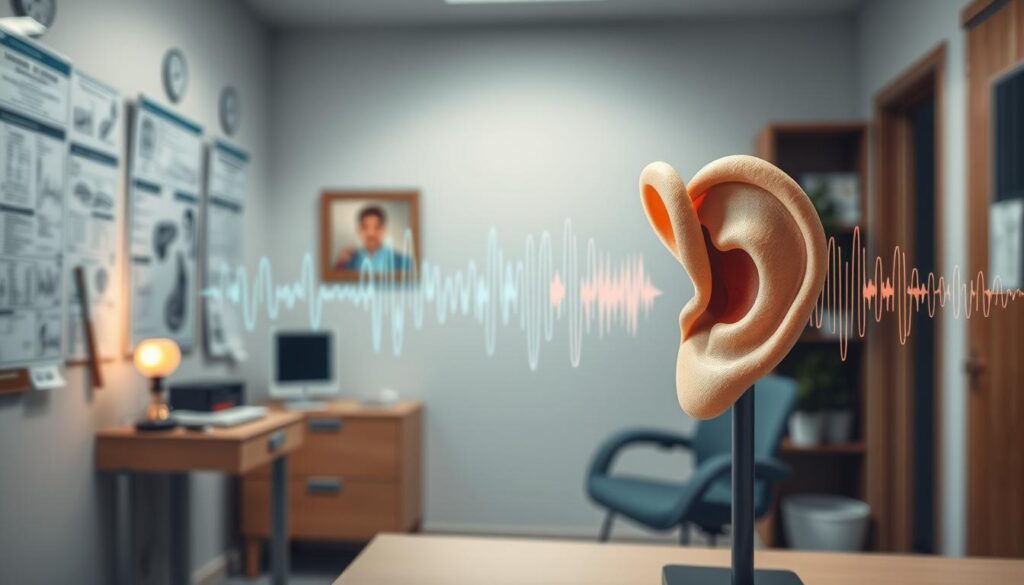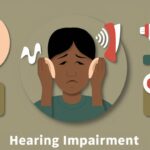Are you an audiologist or healthcare professional looking to understand Hearing Impaired ICD 10 coding for hearing issues? This guide is for you! We’ll explore the details of ICD-10 codes. You’ll learn how to document and bill for the hearing care you offer.
The International Classification of Diseases, 10th Revision, Clinical Modification (ICD-10-CM) is a global coding system. It classifies diseases and health conditions. For audiologists, using ICD-10 codes correctly is key. It affects how insurance and government programs pay you.
By accurately coding your services, you can get paid on time. This avoids claim denials and delays. It’s important for your work to be recognized and valued.If your patients struggle with hearing issues like tinnitus, solutions that enhance hearing and brain function can also play a key role in their care. Learn more about these advancements here.
Key Takeaways
- ICD-10-CM is an alphanumeric coding system used internationally to classify diseases and health conditions.
- Accurate ICD-10 coding is essential for audiologists, as it directly impacts reimbursement and ensures proper documentation of services.
- Proper coding contributes to reliable data collection, quality improvement initiatives, and healthcare policy development.
- The ICD-10-CM coding system provides a comprehensive breakdown of hearing loss subtypes and auditory perception abnormalities.
- Understanding the nuances of ICD-10 coding for hearing-related conditions is crucial for audiologists and healthcare professionals.
Introduction to ICD-10 Codes for Audiology
The world of audiology uses a complex system called the International Classification of Diseases, Tenth Revision (ICD-10). These auditory disorder codes help healthcare professionals talk about hearing issues. They make it easier to document hearing problems, classify hearing loss classifications, and help with deafness diagnosis and getting paid.
For those patients struggling with tinnitus—experiencing whooshing, buzzing, or clicking sounds—there are effective solutions available to restore 20/20 hearing and improve brain function. To explore these options, visit this resource.
Understanding the ICD-10 Code Structure
ICD-10 codes have a special structure. They are made up of letters and numbers. The system has 21 chapters, with many important for audiology, like the H chapter for ear diseases.
These codes can have up to seven characters. They help document a patient’s condition in detail. This includes things like where the problem is, how bad it is, and other important details.
Importance of Accurate ICD-10 Coding
Getting ICD-10 coding right is key for audiologists. It affects how much they get paid from insurance and government programs. By using the right codes, audiologists make sure their work is recognized and paid for. This also helps improve healthcare data and reports.
“For patients dealing with tinnitus, accurate diagnosis and coding can lead to better treatment outcomes. If you’re looking for a way to relieve tinnitus and restore clear hearing, consider exploring innovative solutions available here.
Key Hearing-Related ICD-10 Codes
It’s important to know about ICD-10 codes for hearing issues. This knowledge helps healthcare workers and coders. It’s key for understanding sensorineural and conductive hearing loss.
Sensorineural Hearing Loss Codes
Sensorineural hearing loss comes from problems in the inner ear or auditory nerve. It has several ICD-10 codes. These include:
- H90.3: Bilateral sensorineural hearing loss
- H90.5: Unspecified sensorineural hearing loss
- H90.6: Mixed conductive and sensorineural hearing loss, unspecified
Conductive Hearing Loss Codes
Conductive hearing loss happens in the outer or middle ear. It has its own ICD-10 codes:
- H90.0: Bilateral conductive hearing loss
- H90.2: Unspecified conductive hearing loss
- H90.4: Mixed conductive and sensorineural hearing loss, unilateral
These codes help doctors document and report hearing loss. They ensure the best care and payment for patients.
hearing impaired icd 10
When a patient’s hearing loss type or cause is unknown, doctors use ICD-10 codes. These codes help document and share the details of the hearing issue. This is key for correct diagnosis, treatment, and insurance claims.
Unspecified Hearing Loss Codes
Some important unspecified hearing loss codes in ICD-10 include:
- H91.9: Unspecified hearing loss, including deafness NOS (not specified), high frequency deafness, and low frequency deafness.
- H91.90: Unspecified hearing loss in an unspecified ear.
- H91.8X9: Other specified hearing loss in an unspecified ear.
These codes help doctors document the patient’s condition accurately. They do this without making guesses about the hearing loss type or cause.
Laterality and Severity Specifications
The ICD-10 system also has codes for the side and severity of hearing loss. For example:
- H91.21: Hearing loss, unilateral, right ear, with unrestricted hearing on the contralateral side.
- H91.23: Hearing loss, bilateral.
These codes give more detailed info about the hearing loss. This helps doctors choose the right treatment and management.

Using the right ICD-10 codes for hearing loss is crucial for healthcare. It ensures accurate documentation and coding. This helps in getting the right treatment and insurance coverage for patients.
Coding Conventions and Guidelines
Audiologists need to know the rules of ICD-10 coding. These rules help report hearing issues correctly and consistently.
Code Exclusions and Sequencing
The ICD-10 system has rules for which codes can’t be used together. It also tells us the order of codes. This is important because some codes need to be listed first to show the cause of a condition.
For instance, Z01.118 is for ear and hearing exams. It’s not used for Present On Admission reporting. This code fits into certain health groups.
Audiologists must keep up with ICD-10-CM updates from 2016 to 2025. Claims for services after October 1, 2015, need ICD-10 codes.
- Use the -52 modifier for unilateral testing, except for cochlear implant analysis.
- Get both ipsilateral and contralateral acoustic reflex thresholds for some CPT codes.
- New billing codes for VEMPs started on January 1, 2021. Make sure to use the latest information for billing.
By following ICD-10 rules, audiologists can report icd 10 coding conventions, auditory disorder codes, and hearing loss classifications accurately. This helps with reimbursement and patient care.
ICD-10 Documentation Best Practices
As an audiologist, it’s vital to document patient encounters well. You need to write down the patient’s medical history, symptoms, findings, test results, and treatment plans. The secret to good ICD-10 coding is to be specific in your notes.
Don’t just say “hearing loss.” Be detailed. Mention the exact type, side, and how bad it is. For example, write “bilateral sensorineural hearing loss” instead of just “hearing loss.” This makes your icd 10 documentation more accurate. It also helps pick the right auditory disorder codes and hearing loss classifications.
Here are some tips for coding diagnostic tests:
- Code for the test result.
- If the test is normal, pick a code that shows why the test was done and the main problem.
Following these tips helps make sure your ICD-10 documentation really gets what’s going on with your patients’ hearing loss. This leads to better care and payment.
“For patients experiencing tinnitus or other hearing-related challenges, addressing these issues with targeted treatments is crucial. To learn more about products that can alleviate tinnitus and enhance hearing function, check out this link.
Check out This Post: https://healthsuccesful.com/choosing-the-right-ear-protection-for-concerts-and-events/
Conclusion
Mastering ICD-10 coding is critical for audiologists. It ensures that their services are documented accurately and reimbursed appropriately. By understanding the structure and specific codes for hearing loss, audiologists can improve their billing processes, contribute to better healthcare outcomes, and support patient care.
For patients suffering from tinnitus or hearing loss, there are advanced products designed to restore hearing clarity and enhance brain function. To explore the best solutions for tinnitus relief, visit this link. Accurate diagnosis and the right product can help transform lives, ensuring that patients receive the care and support they need.
FAQ
What is the purpose of ICD-10 coding for audiologists?
ICD-10 coding is vital for audiologists. It affects how much money they get from insurance and government programs. Good coding helps avoid claim denials and delays in payment.
How is the ICD-10 coding system structured?
The ICD-10 system has a clear structure. It has categories, subcategories, and specific codes. Each code can have up to seven characters for detailed patient records.
What are some key hearing-related ICD-10 codes?
There are important codes for hearing loss. For sensorineural hearing loss, there are H90.3 for both ears and H90.5 for unspecified loss. For conductive hearing loss, there are H90.0 for both ears and H90.2 for unspecified loss.
There are also codes for mixed hearing loss, like H90.4. These help document patient conditions accurately.
What types of unspecified hearing loss codes are available?
There are codes for unspecified hearing loss. H91.9 is for unspecified loss, and H91.90 is for an unspecified ear. H91.8X9 is for other specified loss in an unspecified ear.
These codes are used when the exact cause of hearing loss is unknown.
What coding conventions and guidelines should audiologists be aware of?
Audiologists need to know certain coding rules. They should use “other” or “not elsewhere classified” (NEC) codes and “unspecified” (NOS) codes. They also need to follow “type 1 excludes” and “type 2 excludes” notes.
It’s also important to sequence codes correctly.
What are the best practices for ICD-10 documentation?
Audiologists should document patient encounters fully. This includes medical history, symptoms, findings, test results, and treatment plans. Being specific is crucial, like using “bilateral sensorineural hearing loss” instead of just “hearing loss”.
Source Links
- Unspecified hearing loss, unspecified ear – https://www.icd10data.com/ICD10CM/Codes/H60-H95/H90-H94/H91-/H91.90
- Other specified hearing loss, unspecified ear – https://www.icd10data.com/ICD10CM/Codes/H60-H95/H90-H94/H91-/H91.8X9
- Other and unspecified hearing loss – https://www.icd10data.com/ICD10CM/Codes/H60-H95/H90-H94/H91-
- ICD-10 Diagnosis Coding for Audiologists – American Academy of Audiology – https://www.audiology.org/practice-resources/coding/icd-10-codes-for-audiology/
- 2023 ICD-10-CM Diagnosis Codes Related to Hearing and Vestibular Disorders – https://www.asha.org/siteassets/uploadedfiles/icd-10-codes-audiology.pdf
- PDF – https://vestibular.org/sites/default/files/Cynthia/ICD_10_SuperbillTemplate_AAALetterhead.pdf
- Learn About Several New ICD-10 Codes for Hearing Loss – https://www.outsourcestrategies.com/blog/coding-for-hearing-loss-in-icd-10/
- Unspecified disorder of ear, unspecified ear – https://www.icd10data.com/ICD10CM/Codes/H60-H95/H90-H94/H93-/H93.90
- 2025 ICD-10-CM Diagnosis Code H91.93: Unspecified hearing loss, bilateral – https://www.icd10data.com/ICD10CM/Codes/H60-H95/H90-H94/H91-/H91.93
- Deaf nonspeaking, not elsewhere classified – https://www.icd10data.com/ICD10CM/Codes/H60-H95/H90-H94/H91-/H91.3
- Unspecified hearing loss, right ear – https://www.icd10data.com/ICD10CM/Codes/H60-H95/H90-H94/H91-/H91.91
- Billing and Coding for Audiology Services – American Academy of Audiology – https://www.audiology.org/practice-resources/coding/coding-frequently-asked-questions/billing-and-coding-for-audiology-services/
- Encounter for examination of ears and hearing with other abnormal findings – https://www.icd10data.com/ICD10CM/Codes/Z00-Z99/Z00-Z13/Z01-/Z01.118
- Hearing Loss in ICD-10 – https://www.aapc.com/blog/37501-hearing-loss-in-icd-10/
- ICD-10: Effective Implementation in an Audiology Practice – https://www.audiologyonline.com/articles/icd-10-effective-implementation-in-14492
- ICD-10 Coding Scenarios for Family Practice – https://www.practicefusion.com/icd-10/clinical-concepts-for-family-practice/icd-10-clinical-scenarios/
- Sudden Sensorineural Hearing Loss Associated with Nutritional Anemia: A Nested Case–Control Study Using a National Health Screening Cohort – https://www.ncbi.nlm.nih.gov/pmc/articles/PMC7558085/
- 2023 ICD-10-CM Diagnosis Codes Related to Speech, Language, and Swallowing Disorders – https://www.asha.org/siteassets/uploadedfiles/icd-10-codes-slp.pdf



